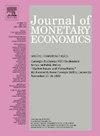Elasticity of substitution between robots and workers: Theory and evidence from Japanese robot price data
IF 4.3
2区 经济学
Q1 BUSINESS, FINANCE
引用次数: 0
Abstract
This paper examines the wage effects of the increased use of industrial robots, focusing on their role in specific tasks and international trade. I construct a novel dataset by tracking shocks to the cost of acquiring robots from Japan, termed the Japan Robot Shock (JRS), and analyze these shocks across different occupations that have adopted robots. A general equilibrium model incorporating robot automation in a large open economy is developed, and a model-implied optimal instrumental variable of the JRS is constructed to address the identification challenges posed by the correlation between automation shocks and the JRS. The study finds that the elasticity of substitution (EoS) between robots and labor is heterogeneous across occupations, reaching up to 3 in production and material moving occupations, which is significantly higher than the EoS between other capital goods and labor. These findings underscore the importance of targeted policy to help workers adapt and mitigate potential wage pressures.
机器人与工人之间的替代弹性:来自日本机器人价格数据的理论与证据
本文考察了工业机器人使用增加对工资的影响,重点关注它们在特定任务和国际贸易中的作用。我通过跟踪从日本购买机器人成本的冲击,构建了一个新的数据集,称为日本机器人冲击(JRS),并分析了采用机器人的不同职业的这些冲击。建立了大型开放经济中包含机器人自动化的一般均衡模型,并构建了模型隐含的JRS最优工具变量,以解决自动化冲击与JRS之间的相关性带来的识别挑战。研究发现,机器人与劳动力之间的替代弹性(EoS)在不同职业之间存在异质性,在生产和物资运输职业中达到3,显著高于其他资本品与劳动力之间的替代弹性。这些发现强调了有针对性的政策对帮助工人适应和减轻潜在的工资压力的重要性。
本文章由计算机程序翻译,如有差异,请以英文原文为准。
求助全文
约1分钟内获得全文
求助全文
来源期刊

Journal of Monetary Economics
Multiple-
CiteScore
7.20
自引率
4.90%
发文量
90
审稿时长
74 days
期刊介绍:
The profession has witnessed over the past twenty years a remarkable expansion of research activities bearing on problems in the broader field of monetary economics. The strong interest in monetary analysis has been increasingly matched in recent years by the growing attention to the working and structure of financial institutions. The role of various institutional arrangements, the consequences of specific changes in banking structure and the welfare aspects of structural policies have attracted an increasing interest in the profession. There has also been a growing attention to the operation of credit markets and to various aspects in the behavior of rates of return on assets. The Journal of Monetary Economics provides a specialized forum for the publication of this research.
 求助内容:
求助内容: 应助结果提醒方式:
应助结果提醒方式:


